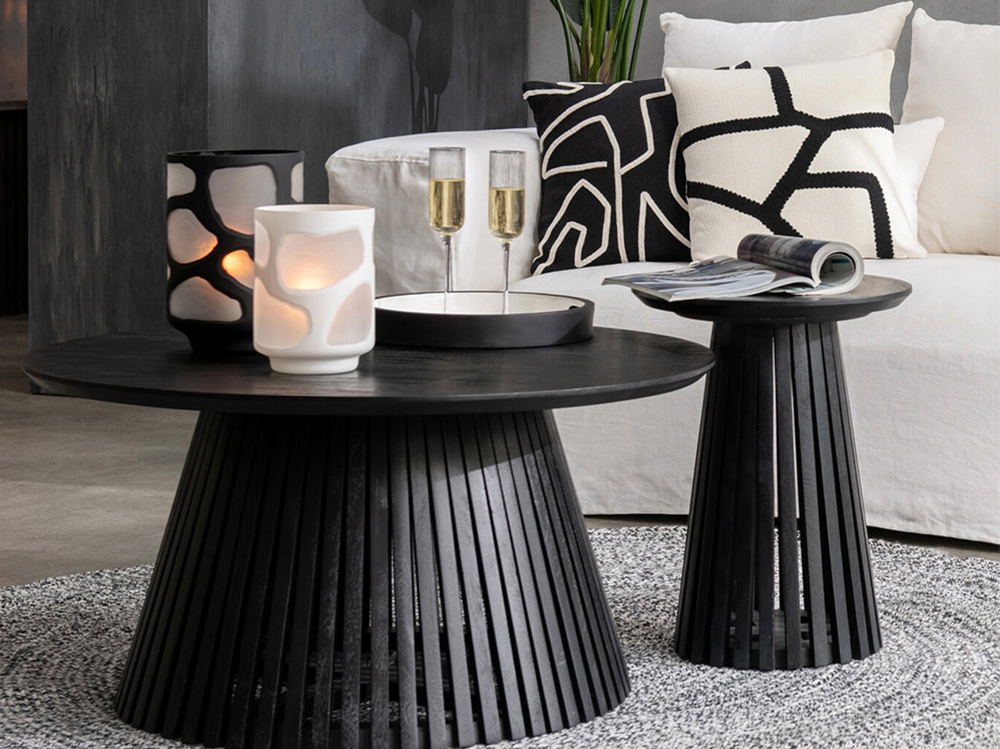A good coffee table doesn’t try to dominate a room; it completes a conversation your sofa has already started. The right shape helps people move easily, keeps drinks within reach, and settles the room’s proportions so everything feels calm. Getting there is mostly measurement and a little psychology—understanding how your household uses the space and how different silhouettes change the way a room breathes. Shape is the lever that does more than any single feature to make a living area feel considered.
Start with the numbers that govern comfort
Before thinking about style, anchor your choice in three simple measurements. First, height: aim for a table roughly level with your sofa seat or within about 5 cm either side. Too high, and your elbows ride up; too low, and you end up leaning and rounding your back. Second, distance from seating: keep about 45–50 cm between the front edge of the sofa and the coffee table so you can stretch your legs yet still reach a cup without a shuffle. Third, length: a useful rule is half to two-thirds of your sofa’s overall length. These benchmarks apply to any coffee table, whether you’re eyeing a glass oval or a solid wood coffee table with storage.
How shape changes traffic flow and sightlines
Rectangles are the most forgiving because rooms and sofas are typically rectangular. A rectangular coffee table echoes that geometry, slipping neatly into the visual grid. It offers clear edges for trays, laptops and board games, which suits households that use the living room for more than the occasional drink.
Ovals do something kind to a room: they borrow the surface area of a rectangle but soften movement. If you’ve got a tight walkway or little ones who sprint through the lounge, those eased ends remove the “sharp-corner” hazard and make the route feel wider than it is. They also cheat a bit on proportions—an oval can be slightly longer without looking heavy.
Rounds are brilliant where people circulate from several directions or when a room is small and you want to keep corners out of the way. A round coffee table encourages conversation because everyone sits at roughly the same distance from the middle. Pairing a round top with a straight sofa introduces contrast, which can be visually energising without adding clutter.
Squares suit generous rooms or symmetrical seating—think two facing sofas or a deep modular. Their equal sides command presence. They can, however, feel bulky in compact spaces, so scale carefully and keep that 45–50 cm circulation gap.
Sectionals, chaises and modular seating
L-shaped and U-shaped arrangements change the rules slightly. You need a shape that allows both legs of the seating to access the surface comfortably. Rectangular tables work if you centre the length along the longer sofa run, but many living rooms feel better with an oval that slides deeper into the corner without pinching knees. With very deep modular sofas, consider an oversize square or a pair of nesting rounds that can drift towards whoever needs them. If your sectional includes a chaise, measure from the inner edge of the chaise to the straight run and choose a table that spans that interior pocket without forcing a sidestep.
Small rooms, big feelings
In compact flats, shape can create the sensation of space without changing the footprint. A round or oval coffee table removes visual brakes—your eye glides past rather than stopping at corners—so the room reads lighter. A pedestal base increases leg clearance and lets your feet tuck underneath, which makes the area feel less cramped. If you love the warmth of a wood coffee table but worry about mass, choose a slim profile top on an open base. You’ll enjoy the material without blocking sightlines.
Children, pets and everyday bumps
If your home has energetic movement, prioritise shapes and edges that forgive. Ovals and rounds reduce bruise potential and are kinder to tails and toddlers. If you prefer a rectilinear look, a waterfall edge (where the top gently curves into the sides) or well-rounded corners can deliver the same safety in a more architectural language. Stability matters too: a heavier solid wood coffee table resists tipping when someone leans on it, but ensure the base doesn’t invite toe stubs.
Material, mood and the weight of forms
Shape and material work together to set the room’s tone. Timber brings warmth and texture; grain can quietly coordinate with flooring, cabinetry or picture frames. A wood coffee table reads grounded, especially in natural finishes. If your scheme leans minimalist, a lighter-coloured oak in a slender oval keeps the look airy. For richer palettes or rooms that need an anchor, a darker walnut rectangle underlines the composition.
Choosing a solid wood coffee table adds depth in a different way: edges can be softened, joints expressed, and the piece can age with your home. Hardwoods develop a gentle patina that rewards care. If you’re pairing solid timber with a bulky sofa, consider a shape that softens the mass—oval or round—so the composition feels balanced. Conversely, if your sofa is slim and raised on legs, a square or rectangle in solid wood can add welcome gravitas.
Storage, nesting and lift-tops—do they change the shape choice?
Function can guide shape decisively. Drawers and lift-tops often appear in rectangles because mechanisms and runners like straight lines. If you work from the sofa or eat there on occasion, a rectangular lift-top is practical and keeps plates steady. Nesting tables frequently come as rounds or soft squares; they let you park a small surface near a side chair when guests arrive, then stack away. If you crave storage without a heavy look, an oval with a low shelf handles remotes and books while staying visually light.
Proportion beyond the sofa
Sofas aren’t the only reference points. Rugs, fireplaces and media consoles also influence what feels “right”. If your rug is rectangular and closely frames the seating, a rectangle or oval keeps the geometry coherent. If the rug is round—less common, but striking—a round coffee table intensifies the statement. Pay attention to vertical mass as well: a very tall media wall may benefit from the calm of a low, broad rectangle; a minimal media shelf might appreciate the personality of a sculptural round.
Try the shape on the floor before you commit
There’s a quick method that prevents guesswork. Mark the proposed outline with masking tape or paper on the floor at the exact measurements you’re considering. Live with it for two days. Walk your normal routes, sit, stretch, set a tray down. Do you clip the corners when you pass? Does the gap to the sofa feel easy? If you share the space, have everyone test their usual habits—laptop work, play, reading. Shape is a lived experience as much as a drawing.
Bringing it together: a simple decision path
If your room is straightforward—a sofa facing a media console with decent width—start with a rectangle. If walkways are tight or you want a gentler look, pivot to an oval of similar length. If seating wraps around or you host often, consider a round for equal access. For large, symmetrical layouts, try a square or a generous pair of rounds. Throughout, keep the practical ratios in view: half to two-thirds the sofa length, 45–50 cm to the seat, and a height close to your cushion top.
When you factor in material, let the rest of the room guide you. A wood coffee table warms cool palettes and adds tactile interest. A solid wood coffee table deepens the story with visible grain and substance—lovely in homes where furniture is meant to last and mellow. Glass and stone have their place, but wood’s ability to echo flooring and cabinetry often ties a space together without effort.
The calm that follows a well-chosen shape
The best sign you’ve picked correctly is silence: the table holds what it needs to, people flow around it without thought, and the room feels settled. Shape did most of that work. Whether you land on a classic rectangle, a family-friendly oval, a sociable round or a commanding square, use your measurements to frame the choice and your household’s habits to finish it. The result is a coffee table that belongs—to the room, to your routines, and to the way you want your home to feel.



